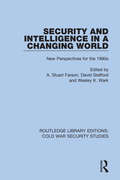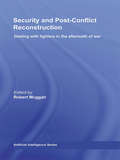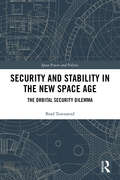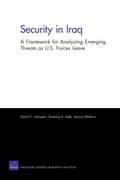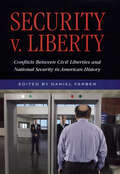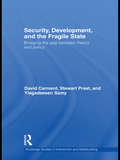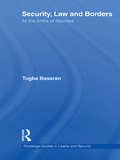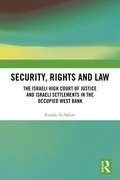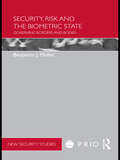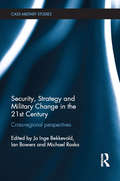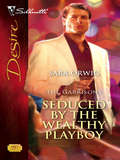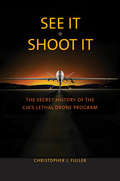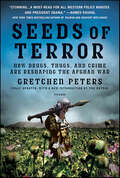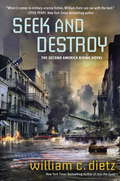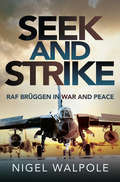- Table View
- List View
Security and Intelligence in a Changing World: New Perspectives for the 1990s (Routledge Library Editions: Cold War Security Studies #43)
by A. Stuart FarsonThis book, first published in 1991, examines the changes to security and intelligence agencies envisioned in the uncertain world at the end of the Cold War. While the central focus is on the Canadian Security Intelligence Service, its history, function and future, there are also comparative studies of the British, Soviet, American and Australian systems.
Security and Post-Conflict Reconstruction: Dealing with Fighters in the Aftermath of War (Routledge Global Security Studies #8)
by Robert MuggahThis book provides a critical analysis of the changing discourse and practice of post-conflict security-promoting interventions since the Cold War, such as disarmament, demobilization and reintegration (DDR), and security-sector reform (SSR) Although the international aid and security sectors exhibit an expanding appetite for peace-support operations in the 21st Century, the effectiveness of such interventions are largely untested. This book aims to fill this evidentiary gap and issues a challenge to 'conventional' approaches to security promotion as currently conceived by military and peace-keeping forces, drawing on cutting-edge statistical and qualitative findings from war-torn areas including Afghanistan, Timor Leste, Sudan, Uganda, Colombia and Haiti. By focusing on specific cases where the United Nations and others have sought to contain the (presumed) sources of post-conflict violence and insecurity, it lays out a new research agenda for measuring success or failure. This book will be of much interest to students of peacebuilding, peacekeeping, conflict resolution, conflict and development and security studies in general.
Security and Stability in the New Space Age: The Orbital Security Dilemma (Space Power and Politics)
by Brad TownsendThis book examines the drivers behind great power security competition in space to determine whether realistic strategic alternatives exist to further militarization. Space is an area of increasing economic and military competition. This book offers an analysis of actions and events indicative of a growing security dilemma in space, which is generating an intensifying arms race between the US, China, and Russia. It explores the dynamics behind a potential future war in space and investigates methods of preventing an arms race from an international relations theory and military-strategy standpoint. The book is divided into three parts: the first section offers a broad discussion of the applicability of international relations theory to current conditions in space; the second is a direct application of theory to the space environment to determine whether competition or cooperation is the optimal strategic choice; the third section focuses on testing the hypotheses against reality, by analyzing novel alternatives to three major categories of space systems. The volume concludes with a study of the practical limitations of applying a strategy centered on commercialization as a method of defusing the orbital security dilemma. This book will be of interest to students of space power, strategic studies, and international relations.
Security and the War on Terror (Contemporary Security Studies)
by Richard Devetak Alex J. Bellamy Roland Bleiker Sara E. DaviesThe terrorist attacks of 11 September 2001 marked a turning point in international politics, representing a new type of threat that could not easily be anticipated or prevented through state-based structures of security alone. Opening up interdisciplinary conversations between strategic, economic, ethical and legal approaches to global terrorism, this edited book recognises a fundamental issue: while major crises initially tend to reinforce old thinking and behavioural patterns, they also allow societies to challenge and overcome entrenched habits, thereby creating the foundations for a new and perhaps more peaceful future. This volume addresses the issues that are at stake in this dual process of political closure, and therefore rethinks how states can respond to terrorist threats. The contributors range from leading conceptual theorists to policy-oriented analysts, from senior academics to junior researchers. The book explores how terrorism has had a profound impact on how security is being understood and implemented, and uses a range of hitherto neglected sources of insight, such as those between political, economic, legal and ethical factors, to examine the nature and meaning of security in a rapidly changing world.
Security in Iraq: A Framework for Analyzing Emerging Threats as U. S. Forces Leave
by David C. Gompert Jessica Watkins Terrence K. KellyU.S. withdrawal could affect Iraq's internal security and stability, which could, in turn, affect U.S. strategic interests and the safety of U.S. troops and civilians in Iraq. U.S. policy-makers need a dynamic analytic framework with which to examine the shifting motivations and capabilities of the actors that affect Iraq's security. Within this framework, the United States should be able to contribute to continued strengthening of the internal security and stability of Iraq even as it withdraws its forces.
Security v. Liberty: Conflicts Between National Security and Civil Liberties in American History
by Daniel FarberIn the weeks following 9/11, the Bush administration launched the Patriot Act, rejected key provisions of the Geneva Convention, and inaugurated a sweeping electronic surveillance program for intelligence purposes―all in the name of protecting national security. But the current administration is hardly unique in pursuing such measures. <p><p>In Security v. Liberty, Daniel Farber leads a group of prominent historians and legal experts in exploring the varied ways in which threats to national security have affected civil liberties throughout American history. Has the government's response to such threats led to a gradual loss of freedoms once taken for granted, or has the nation learned how to restore civil liberties after threats subside and how to put protections in place for the future? Security v. Liberty focuses on periods of national emergency in the twentieth century―from World War I through the Vietnam War―to explore how past episodes might bear upon today's dilemma. <p><p>Distinguished historian Alan Brinkley shows that during World War I the government targeted vulnerable groups―including socialists, anarchists, and labor leaders―not because of a real threat to the nation, but because it was politically expedient to scapegoat unpopular groups. Nonetheless, within ten years the Supreme Court had rolled back the most egregious of the World War I restrictions on civil liberties. <p><p>Legal scholar John Yoo argues for the legitimacy of the Bush administration's War on Terror policies―such as the detainment and trials of suspected al Qaeda members―by citing historical precedent in the Roosevelt administration's prosecution of World War II. Yoo contends that, compared to Roosevelt's sweeping use of executive orders, Bush has exercised relative restraint in curtailing civil liberties. <p><p>Law professor Geoffrey Stone describes how J. Edgar Hoover used domestic surveillance to harass anti-war protestors and civil rights groups throughout the 1960s and early 1970s. Congress later enacted legislation to prevent a recurrence of the Hoover era excesses, but Stone notes that the Bush administration has argued for the right to circumvent some of these restrictions in its campaign against terrorism. Historian <p><p>Jan Ellen Lewis looks at early U.S. history to show how an individual's civil liberties often depended on the extent to which he or she fit the definition of "American" as the country's borders expanded. <p><p>Legal experts Paul Schwartz and Ronald Lee examine the national security implications of rapid advances in information technology, which is increasingly driven by a highly globalized private sector, rather than by the U.S. government. <p><p>Security v. Liberty shows that civil liberties are a not an immutable right, but the historically shifting result of a continuous struggle that has extended over two centuries. This important new volume provides a penetrating historical and legal analysis of the trade-offs between security and liberty that have shaped our national history―trade-offs that we confront with renewed urgency in a post-9/11 world.
Security, Development and the Fragile State: Bridging the Gap between Theory and Policy (Routledge Studies in Intervention and Statebuilding)
by David Carment Yiagadeesen Samy Stewart PrestThis book provides theoretical clarity about the concepts of failed and fragile states, which have emerged strongly since the 9/11 attacks. Recent contributions often see the fragile state as either a problem of development or of security. This volume argues that that neither perspective on its own is a sufficient basis for good policy. In a wide-ranging treatment, drawing on large samples as well as case studies, the authors create an alternative model of the fragile state emphasizing the multidimensional, multifaceted nature of the "fragile state problematique". On the basis of their model and empirical evidence, they then derive a number of policy-relevant insights regarding the need for contextualized and ongoing country analysis, the perils and pitfalls of unstructured development assistance, and the need to move whole-of-government approaches from the realm of rhetoric to reality. In offering both a synthesis of existing research and an innovative approach to understanding the fragile state, this volume will be of great interest to students of war and conflict studies, risk, conflict management, and international relations in general. It will also be of use to practitioners in policy circles and to NGOs.
Security, Law and Borders: At the Limits of Liberties (Routledge Studies in Liberty and Security)
by Tugba BasaranThis book focuses on security practices, civil liberties and the politics of borders in liberal democracies. In the aftermath of 9/11, security practices and the denial of human rights and civil liberties are often portrayed as an exception to liberal rule, and seen as institutionally, legally and spatially distinct from the liberal state. Drawing upon detailed empirical studies from migration controls, such as the French waiting zone, Australian off-shore processing and US maritime interceptions, this study demonstrates that the limitation of liberties is not an anomaly of liberal rule, but embedded within the legal order of liberal democracies. The most ordinary, yet powerful way, of limiting liberties is the creation of legal identities, legal borders and legal spaces. It is the possibility of limiting liberties through liberal and democratic procedures that poses the key challenge to the protection of liberties. The book develops three inter-related arguments. First, it questions the discourse of exception that portrays liberal and illiberal rule as distinct ways of governing and scrutinizes liberal techniques for limiting liberties. Second, it highlights the space of government and argues for a change in perspective from territorial to legal borders, especially legal borders of policing and legal borders of rights. Third, it emphasizes the role of ordinary law for illiberal practices and argues that the legal order itself privileges policing powers and prevents access to liberties. This book will be of interest to students of critical security studies, social and political theory, political geography and legal studies, and IR in general.
Security, Loyalty, and Science (Cornell Studies in Civil Liberties)
by Walter GellhornBoth sides of a sensitive problem are assessed by Professor Gellhorn in this penetrating analysis of national security and its effect upon scientific progress.The costs and advantages of secrecy in certain areas of science and the conflict between national safety and individual rights in the administration of our federal loyalty program are presented; all the arguments are objectively weighed. The book answers such questions as: Can young scientists be well trained when publication and teaching are not free? Have we gone far enough-or too far-in avoiding "security risks" in important scientific establishments? How does the federal drive against "potentially disloyal" persons actually work? Do "fear of the smear" and crude methods discourage public service by American scientists?This study, a unit of an investigation of control of subversive activities supported by grants from the Rockefeller Foundation, is based upon two years of research and numerous field interviews of scientists, administrators, defense officials, and educators. Security, Loyalty, and Science is a volume in the series Cornell Studies in Civil Liberty, of which Robert E. Cushman is advisory editor.
Security, Rights and Law: The Israeli High Court of Justice and Israeli Settlements in the Occupied West Bank (Comparative Constitutionalism in Muslim Majority States)
by Rouba Al-SalemThis book examines how the Israeli High Court of Justice (HCJ) has interpreted and applied international law principles in adjudicating petitions filed by Palestinians. The research focuses on HCJ judgments that have been rendered since the outbreak of the Second Intifada (2000) in relation to petitions challenging the legality of measures implemented by various Israeli governments and military authorities for the professed need of enhancing the security of Israeli settlements and settlers in the occupied West Bank. It discusses to what extent the HCJ provides a venue for an effective domestic remedy for alleged violations of the Palestinians’ internationally protected rights. It further analyses the judgments of the Court seeking to demonstrate why it appears to show a preference for invoking principles of Israeli administrative and constitutional law, thereby promoting the domestic rather than international Rule of Law. Although the jurisprudence of the HCJ has often been hailed as that of an ‘activist’ court, the analysis of petitions adjudicated by the Court between 2000 and 2014 illustrates why its approach is ill-suited to a situation of prolonged military occupation. Finally, the book evaluates what impact the Court’s adjudication, reasoning and interpretation has on the normative coherence of the international law of belligerent occupation.
Security, Risk and the Biometric State: Governing Borders and Bodies (PRIO New Security Studies)
by Benjamin J MullerThis book examines a series of questions associated with the increasing application and implications of biometrics in contemporary everyday life. In the wake of the events of 9/11, the reliance on increasingly sophisticated and invasive technologies across a burgeoning field of applications has accelerated, giving rise to the term 'biometric state'. This book explores how these ‘virtual borders’ are created and the effect they have upon the politics of citizenship and immigration, especially how they contribute to the treatment of citizens as suspects. Finally and most importantly, this text argues that the rationale of 'governing through risk' facilitates pre-emptory logics, a negligent attitude towards 'false positives', and an overall proliferation of borders and ubiquitous risk, which becomes integral to contemporary everyday life, far beyond the confined politics of national borders and frontiers. By focusing on specific sites, such as virtual borders in airports, trusted traveller programs like the NEXUS program and those delivered by airlines and supported by governmental authorities (TSA and CATSA respectively), this book raises critical questions about the emerging biometric state and its commitment and constitution vis-à-vis technology of ‘governing through risk’. This book will be of interest to students of biopolitics, critical security, surveillance studies and International Relations in general. Benjamin J. Muller is assistant professor in International Relations at Simon Fraser University, Burnaby, Canada. He completed his PhD in the School of Politics and International Studies at Queen’s University Belfast, Northern Ireland, in 2005.
Security, Strategy and Military Change in the 21st Century: Cross-Regional Perspectives (Cass Military Studies)
by Jo Inge Bekkevold Ian Bowers Michael RaskaThis edited volume explores and analyses strategic thinking, military reform and adaptation in an era of Asian growth, European austerity and US rebalancing. A significant shift in policy, strategy and military affairs is underway in both Asia and Europe, with the former gaining increasing prominence in the domain of global security. At the same time, the world’s powers are now faced with an array of diverse challenges. The resurgence of great power politics in both Europe and Asia, along with the long term threats of terrorism, piracy and sustained geopolitical instability has placed great strain on militaries and security institutions operating with constrained budgets and wary public support. The volume covers a wide range of case studies, including the transformation of China’s military in the 21st century, the internal and external challenges facing India, Russia’s military modernization program and the USA’s reassessment of its strategic interests. In doing so, the book provides the reader with the opportunity to conceptualize how strategic thinking, military reform, operational adaptation and technological integration have interacted with the challenges outlined above. With contributions by leading scholars and practitioners from Europe and Asia, this book provides a valuable contribution to the understanding of strategic and operational thinking and adjustment across the world. This book will be of much interest to students of military and strategic studies, security studies, defence studies, Asian politics, Russian politics, US foreign policy and IR in general.
Seduced by Her Rebel Warrior (Harlequin Historical Ser.)
by Greta GilbertA forbidden warriorAn irresistible seduction!Atia’s father, a Roman governor, wants her help to quash a rebellion in his lands. But ordered to keep a close eye on a rebel prisoner, Rab, downtrodden Atia is utterly spellbound. When she’s sent with Rab on a punishing mission through Arabia, their instant, wild attraction becomes a powerful longing. Atia must choose: guard her damaged heart forever or surrender to the promise of pleasure in Rab’s arms…“Singing with atmosphere and with scholarship, In Thrall to the Enemy Commander gives us an enigmatic heroine who fascinates at every turn, and immerses us fully in a world long-gone, but wonderfully-conjured.”— Romantic Intentions Quarterly on In Thrall to the Enemy Commander“Greta Gilbert is a truly gifted author…This amazing story has it all. Suspense, intrigue, duplicity, conspiracies, betrayal and most abundantly it has love.”— Goodreads on In Thrall to the Enemy Commander
Seduced by the Scoundrel (Danger & Desire #1080)
by Louise AllenA naval captain’s secret Mediterranean mission is interrupted by a shipwrecked beauty in this steamy historical romance adventure.Shipwrecked and washed up on an island, Averil Heydon is terrified—and being rescued by mysterious roguish naval captain Luc d’Aunay doesn’t calm her fears! Virginal Averil knows that falling for Luc is dangerous, but the pull of their sexual attraction is deliciously irresistible. . . .After her first taste of wild desire in Luc’s arms, Averil must return to society and convention. Except Luc has a shockingly tempting proposition for her—to flaunt duty, and give in to her newly awakened sensuality . . .
Seduced by the Sniper: A Thrilling FBI Romance (The Lawmen #2)
by Elizabeth HeiterZeroed in on one woman... In a twenty-four-hour period, FBI negotiator Chelsie Russell's life changed. She was a promising negotiator for the Bureau, but then she failed to talk down a crazed gunman. A year later the killer has escaped, and sniper Scott Delacorte has stepped up to protect Chelsie. Scott is the FBI's most infamous playboy-and the guy Chelsie had a one-night fling with just before the shooting. She'd dismissed him as the love 'em and leave 'em type, but now he stands between her and a killer. When the investigation takes an unexpected turn, powerful people become desperate to keep Scott and Chelsie silent-dead silent. Chelsie knows it's time to put aside their past and trust this man who has the power to break her heart. Again.
Seduced by the Wealthy Playboy (The Garrisons #1813)
by Sara OrwigUnless Brittany Garrison came up withcold hard cash right away, she'd lose herbeloved restaurant. So when handsomemillionaire Emilio Jefferies offered her anirresistible proposition, Brittany signedon the dotted line and sealed the dealwith a kiss-unaware of the family feudbetween the Jefferies and the Garrisons.Or Emilio's cruel intentions.Emilio hadn't expected the takeover-business and body-of Brittany Garrison to be so easy. But he also didn't counton Brittany owning a part of him.
See It/Shoot It: The Secret History of the CIA's Lethal Drone Program
by Christopher J. FullerAn illuminating study tracing the evolution of drone technology and counterterrorism policy from the Reagan to the Obama administrations This eye-opening study uncovers the history of the most important instrument of U.S. counterterrorism today: the armed drone. It reveals that, contrary to popular belief, the CIA’s covert drone program is not a product of 9/11. Rather, it is the result of U.S. counterterrorism practices extending back to an influential group of policy makers in the Reagan administration. Tracing the evolution of counterterrorism policy and drone technology from the fallout of Iran-Contra and the CIA’s “Eagle Program” prototype in the mid-1980s to the emergence of al-Qaeda, Fuller shows how George W. Bush and Obama built upon or discarded strategies from the Reagan and Clinton eras as they responded to changes in the partisan environment, the perceived level of threat, and technological advances. Examining a range of counterterrorism strategies, he reveals why the CIA’s drones became the United States’ preferred tool for pursuing the decades-old goal of preemptively targeting anti-American terrorists around the world.
Seeds of Terror: An Eyewitness Account of Al Qaeda's Newest Center of Operations in Southeast Asia
by Maria RessaFor anyone wishing to understand the next, post-9/11 generation of al-Qaeda planning, leadership, and tactics, there is only one place to begin: Southeast Asia. In fact, such countries as the Philippines, Indonesia, Thailand, and Malaysia have been crucial nodes in the al-Qaeda network since long before the strikes on the Pentagon and World Trade Center, but when the allies overran Afghanistan, the new camps in Southeast Asia became the key training grounds for the future. It is in the Muslim strongholds in the Philippines and Indonesia that the next generation of al-Qaeda can be found. In this powerful, eye-opening work, Maria Ressa casts the most illuminating light ever on this fascinating but little-known "terrorist HQ." Every major al-Qaeda attack since 1993 has had a connection to the Philippines, and Maria Ressa, CNN's lead investigative reporter for Asia and a Filipino-American who has lived in the region since 1986, has broken story after story about them. From the early, failed attempts to assassinate Pope John Paul II and Bill Clinton to the planning of the 9/11 strikes and the "48 Hours of Terror," in which eleven American jetliners were to be blown up over the Pacific, she has interviewed the terrorists, their neighbors and families, and the investigators from six different countries who have tracked them down. After the Bali bombing, al-Qaeda's worst strike since 9/11, which killed more than two hundred, Ressa broke major revelations about how it was planned, why it was a Plan B substitute for an even more ambitious scheme aimed at Singapore, and why the suicide bomber recruited to deliver the explosives almost caused the whole plan to fall apart when he admitted he could barely drive a car. Above all, Ressa has seen how al-Qaeda's tactics are shifting under the pressures of the war on terror. Rather than depending upon its own core membership (estimated at three to four thousand at its peak), the network is now enmeshing itself in local conflicts, co-opting Muslim independence movements wherever they can be found, and helping local "revolutionaries" to fund, plan, and execute sinister attacks against their neighbors and the West. If history is any guide, al-Qaeda revisits its plans over and over until they can succeed -- and many of those plans have already been discovered and are here revealed, thanks to classified investigative documents uncovered by Ressa.
Seeds of Terror: How Drugs, Thugs, and Crime Are Reshaping the Afghan War
by Gretchen PetersSeeds of Terror is a groundbreaking triumph of reporting, a book that changed U.S. policy toward the Afghan heroin trade and the fight against terror.Gretchen Peters exposes the deepening relationship between the Taliban and drug traffickers, and traces decades of America's failure to disrupt the opium production that helps fund extremism. The Taliban earns as much as half a billion dollars annually from drugs and crime, and Peters argues that disrupting this flow of dirty money will be critical to stabilizing Afghanistan. Based on hundreds of interviews with fighters, smugglers, and government officials, Seeds of Terror is the essential story of the narco-terror nexus behind America's widening war in Afghanistan.
Seeds of Victory: Defeat, Triumph, and the American Way of War
by James EllmanHow pivotal American defeats fueled crucial victories through resilience and strategic adaptation, shaping the nation's path from loss to triumph in warfareLike all armed forces, the United States military—while celebrated for its victories—has been repeatedly defeated on the battlefield throughout its long history. Unlike other nations, the United States has shown a remarkable ability to bounce back from defeat: to learn from the loss, recover, and achieve victory. In this book James Ellman, who has established a reputation for his reconsiderations of military history, takes a close look at eight such pivot points on the ground, in the air, and at sea, from the American Revolution through the Korean War:Long Island (1776) to Trenton and Princeton (1777)Charleston (1780) to Cowpens and Guilford Court House (1781)Invasion of Canada (1812) to Battles of Lake Erie and the Thames (1813)First Bull Run (1861) to Antietam (1862)Pearl Harbor (1941) to Midway (1942)Luzon (1942) to Buna-Gona (1943)Schweinfurt (1943) to the "Big B" (1944)Chongchon River (1950) to Operation Ripper (1951)In brisk narratives, Ellman describes each battle, explaining how it was fought and lost, and then shifts gears to detail how leaders—military as well as civilian—such as George Washington, Abraham Lincoln, Chester Nimitz, Douglas MacArthur, James Doolittle, and Matthew Ridgway assessed the factors that led to defeat, and made changes to training, tactics, and strategy, so that American forces entered the next battle wiser and able to win.Ellman then uses this framework to evaluate the wars waged in more recent decades in Vietnam, Afghanistan, and Iraq. Surprisingly, despite the accepted consensus that these conflicts resulted in painful defeats, the American military repeatedly showed its historic ability to react and recover, and if not achieve victory, at least stabilize the situation on the battlefield. While US forces eventually pulled out of these three conflicts, the overarching Cold War and War on Terror were still concluded in America&’s favor.As this book makes clear, the history of the United States at war is, to a surprising degree, the story of tenacity in the wake of defeat, of flexibility and adaptability on the path to victory. This is essential reading for understanding how battles are lost and won.
Seeing Redd (The Looking Glass Wars #2)
by Frank BeddorWhen Alyss Heart returns to her rightful place on the throne of Wonderland, she is put to the test as enemies, both inside and outside the borders of her queendom, push their own agendas, while she strives to unify them all.
Seek Out and Destroy (Commander Cochrane Smith Naval Thrillers)
by Alan EvansCommander David Cochrane Smith is about to embark on his most perilous adventure yet.November, 1917: The Imperial German Navy has sent Kapitan Erwin Voss to command the mighty new battle cruiser Salzburg in the Adriatic. Smith is ordered by the Admiralty to seek out and destroy her in harbour – a seemingly suicidal task which is made all the more hopeless when he runs into the opposition of his superiors in Venice.But it is a vital mission, and Smith knows he must go it alone. Though the odds are stacked against him and his tiny crew, his orders are inflexible: seek out and destroy!This thrilling naval adventure is perfect for fans of Douglas Reeman and Julian Stockwin.Praise for Alan Evans'I think a 21 gun salute is required…Alan Evans has produced a cracking thriller' Daily Mirror'Evans provides a different sea story, sustained suspense and vivid battle scenes' Publishers Weekly
Seek and Destroy
by William C. DietzFrom the New York Times bestselling author of the Legion of the Damned® novels and the Mutant Files series comes the second novel in a postapocalyptic military science fiction series about America struggling to overcome a natural disaster but starting a second civil war…As people fight to survive the aftereffects of more than a dozen meteor strikes, a group of wealthy individuals conspires to rebuild the United States as a corporate entity called the New Confederacy, where the bottom line is law. As a second civil war rages, with families fighting against families on opposite sides, Union president Samuel T. Sloan battles to keep the country whole.To help in the fight for unity, Union Army captain Robin “Mac” Macintyre and her crew of Stryker vehicles are sent after the ruthless “warlord of warlords,” an ex–Green Beret who rules a large swath of the West. But defeating him will be even more difficult than she thought. The warlord is receiving military assistance from Mac’s sister—and rival—Confederate major Victoria Macintyre. And when the siblings come together in the war-torn streets of New Orleans, only one of them will walk away.From the Hardcover edition.
Seek and Strike: RAF Brüggen in War and Peace
by Nigel Walpole&“A slice of the RAF and NATO in Germany through the Cold War . . . cover[s] the range of jets used by the RAF, from the Vampire to the Tornado.&” —Firetrench This is an anecdotal history of the largest RAF station in Germany. Optimized for a new breed of aircraft, and to NATO requirements, this huge airfield was cut out of the Elmpt Forest, on the German border with Holland, and completed in one year to become operational in 1953. First occupied by a fighter wing equipped with Vampires, Sabres and Hunters, its &“Seek and Strike&” motif took on real meaning when the station re-equipped with strike, attack and reconnaissance Canberras, followed by strike/attack Phantoms, Jaguars and finally Tornados. RAF Brüggen was at the forefront of the Cold War, during which innovation and determination brought it many accolades. It further distinguished itself in the Gulf War and continued to play its part in subsequent monitoring operations in that theater; it was also the only Tornado Wing to operate directly from its home base during the Kosovo campaign. This is the story of a station at war, of the men and women at the sharp end and in support. At work and play, it was they who made Brüggen what it was, excelling in all things and justifying a claim to have been RAF Germany&’s &“jewel in the crown.&” With its closure in 2001, the RAF relinquished its last main operating base outside the UK. Brüggen was indeed &“last and best.&” &“A story of the people who served at Brüggen, their families and the local population, and how their lives were entwined with the station.&” —Flight Line Book Review
Seek and Strike: RAF Brüggen in War and Peace
by Nigel Walpole&“A slice of the RAF and NATO in Germany through the Cold War . . . cover[s] the range of jets used by the RAF, from the Vampire to the Tornado.&” —Firetrench This is an anecdotal history of the largest RAF station in Germany. Optimized for a new breed of aircraft, and to NATO requirements, this huge airfield was cut out of the Elmpt Forest, on the German border with Holland, and completed in one year to become operational in 1953. First occupied by a fighter wing equipped with Vampires, Sabres and Hunters, its &“Seek and Strike&” motif took on real meaning when the station re-equipped with strike, attack and reconnaissance Canberras, followed by strike/attack Phantoms, Jaguars and finally Tornados. RAF Brüggen was at the forefront of the Cold War, during which innovation and determination brought it many accolades. It further distinguished itself in the Gulf War and continued to play its part in subsequent monitoring operations in that theater; it was also the only Tornado Wing to operate directly from its home base during the Kosovo campaign. This is the story of a station at war, of the men and women at the sharp end and in support. At work and play, it was they who made Brüggen what it was, excelling in all things and justifying a claim to have been RAF Germany&’s &“jewel in the crown.&” With its closure in 2001, the RAF relinquished its last main operating base outside the UK. Brüggen was indeed &“last and best.&” &“A story of the people who served at Brüggen, their families and the local population, and how their lives were entwined with the station.&” —Flight Line Book Review
